Here at Suttons, we know that outdoor space is often at a premium. But that doesn’t mean you can’t taste the delights of homegrown fruit from your own garden. From dwarf patio varieties to larger specimen fruit trees, we select those that crop reliably but won’t grow too large and uncontrollable. In fact, our high quality trees are from the same plantations that supply the best commercial growers.
To get your new fruit trees off to the best start, read our horticultural team’s planting and care advice. In the meantime, browse our full range of fruit trees for inspiration.
What is a ‘feathered maiden’ fruit tree?
At Suttons, we supply ‘feathered maiden’ fruit trees. This simply means that the trees are between 18 months and two years old when you receive them – and the term ‘feathering’ refers to the development of side branches. The extent of this is dependent on variety and, apart from some exceptions like Bramley apple trees, which only naturally feather from around the third year, feathering is usually well established in the trees we supply.
What is a bare root fruit tree?
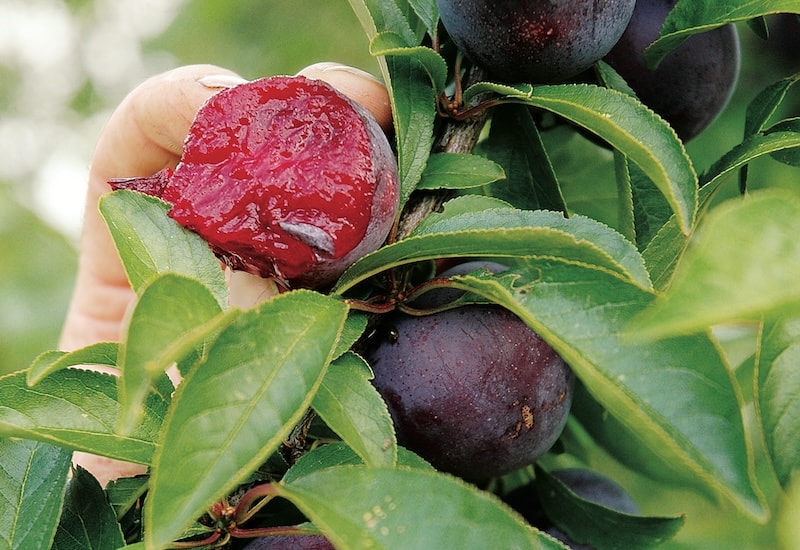
Image: Plum Tree ‘Beauty’ from Suttons
As well as being well ‘feathered’, we supply many of our trees as bare roots ready for planting immediately upon receipt. Bare root fruit trees are grown in the ground rather than a container, and delivered in special packaging without a pot or soil. To prepare our trees, we dig them up during the dormant season between November and March and store them for several weeks in our special cold-treatment facility, which subjects the roots to the low temperatures they need to prime them for strong growth as they establish. Working with some of the leading growers in Britain and Europe, we offer the very latest varieties and also include the best selections of some of your old favourites, ensuring an unbeatable range of terrific fruit trees.
Where should you plant fruit trees?
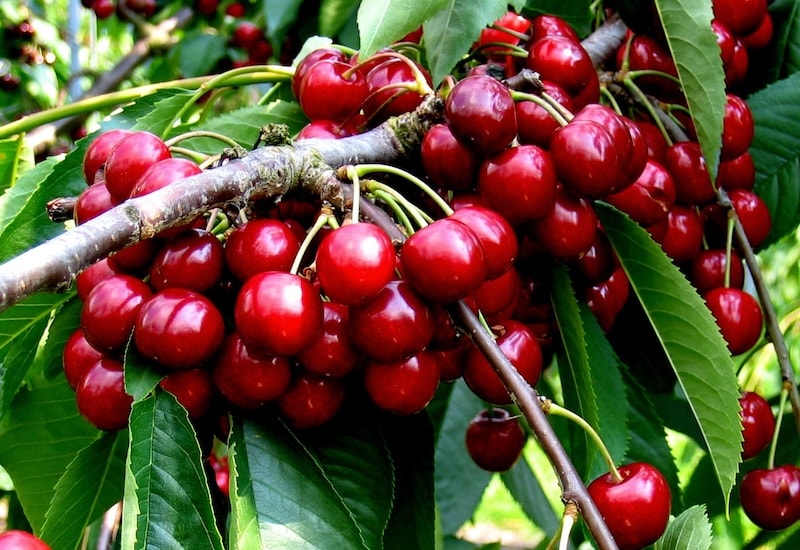
Image: Cherry (Prunus) ‘Stella’ from Suttons
Fruit trees grow well in most soil types, provided the ground is not waterlogged. Plenty of sunlight is essential, however, and areas of deep shade should be avoided. Areas that have previously grown fruit should not be used as this avoids the risk of ‘re-plant disease’.
How to plant fruit trees
A few days before planting your trees, give the ground a good dig over to at least two spade depths. Add a generous amount of garden compost or well-rotted manure and a dressing of bone meal at 105–140 gms per sq.m. (3–4oz per sq yd). If you’re unable to plant your trees within a week of receiving them, dig a hole in a sheltered spot and ‘heel’ the trees into it – lie the trees down and cover the roots with soil and firm down.

Image: Suttons
Before you plant your tree, first give the roots a soak for about 4 hours. We recommend a solution of seaweed extract like Maxicrop for this purpose as it contains many ingredients which aid plant growth and to which young fruit trees respond very well.
Many fruit trees have relatively shallow root systems, and we strongly recommend that you use a high-quality stake that you can leave in place for a number of years. Always position your stake before planting the tree to avoid damaging the roots.
When planting a tree into its final position, prepare a hole about 15cm (6″) wider than the spread roots of the tree and deep enough to allow it to sit at the same depth it was growing at the nursery – a soil mark on the stem should indicate the level. The union on grafted trees needs to stay around 15cm (6″) above soil level. Check that the soil at the bottom of the hole is loose enough to allow the developing roots to easily penetrate. Place your tree into the hole and spread out the roots.
Backfill the hole using layers of soil, firming each with your foot before proceeding with the next. The final layer should be left loose to allow easy ingress of water to the roots. Water in well after planting. To prevent damage, use a purpose-made soft tree tie that can be loosened periodically as the tree grows. A very effective and inexpensive alternative is to use an old pair of ladies’ tights tied in a figure of eight around the stake and tree; this will secure the tree and act as a cushion against wind rock.
How to plant fruit trees in containers
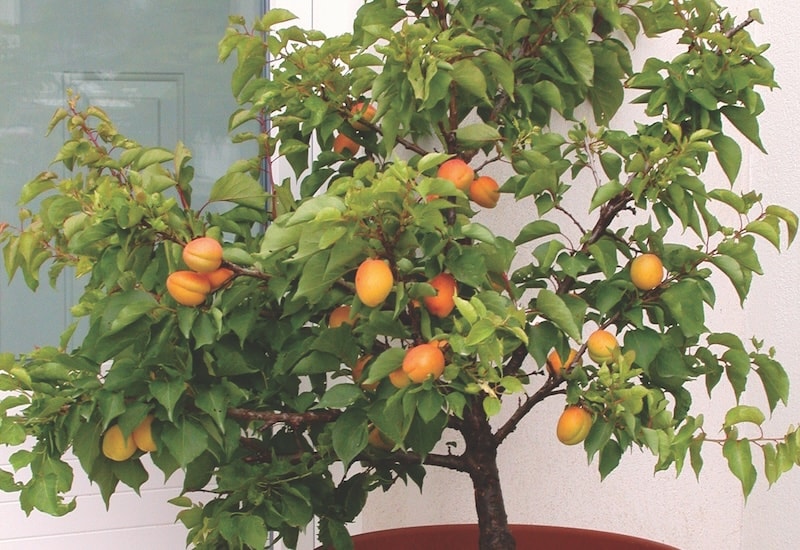
Image: Patio fruit trees from Suttons
If you’re growing fruit trees in containers, choose a sunny, sheltered position on your patio, decking or balcony. For the best results, use a 30-litre pot (or larger) and avoid lightweight plastic containers that are easily blown over. For added stability, we recommend using a heavier soil-based compost such as John Innes Number 3. Good drainage is essential, and small stones or gravel should be placed in the bottom of the container. Position your fruit tree in the container so the graft will be about 2–5cm (1″) above soil level.
Fill the container with compost to within 2.5cm (1″) of the rim, firming as you go and ensuring there are no air pockets around the roots. Keep the compost moist, and feed with a high potash liquid fertiliser from flowering until just before harvesting. After 4-5 years, wait until the tree is dormant and replant it into a 35 litre or larger container, pruning it hard and removing 20–30% of the roots.
How to care for your fruit trees
As soon as your young fruit tree(s) burst into leaf in the spring, you must water to maintain adequate moisture, especially during hot, dry spells. Do not over-water, however, as this encourages shallow rooting. A useful aid to watering is a piece of drainpipe which has holes drilled through it. Sink this into the soil next to the stake before planting, allowing water to be easily introduced at the root level. Keep the area around your trees free from weeds, as any competition will harm their development.
A summer mulch of straw, compost or well-rotted manure helps the soil retain moisture and provides a trickle of nutrients. Apply when the soil is wet after a rainy day, but don’t allow the mulch to touch the trunk of the tree.
How to prune your fruit trees

Image: Apple Tree ‘Queen Cox’ Self Fertile from Suttons
The basis of all pruning is to maintain a balanced tree with a pleasing shape and a good open structure that allows plenty of light and air to get to the ripening fruits. Poorly placed, damaged and diseased branches should be removed, and a constant supply of new branches encouraged as the younger wood is far more productive and gives the highest quality fruit.
For more information on pruning, please head over to our guide to growing and training apple trees which provides useful pruning tips for apples and pears. For advice on pruning stone fruits, check out our expert guide to growing plum trees. It takes a little practice, but over time, you will become more adept at pruning and better able to predict the way in which the removal of one branch will affect the development of others.
Fruit ‘set’ and thinning advice
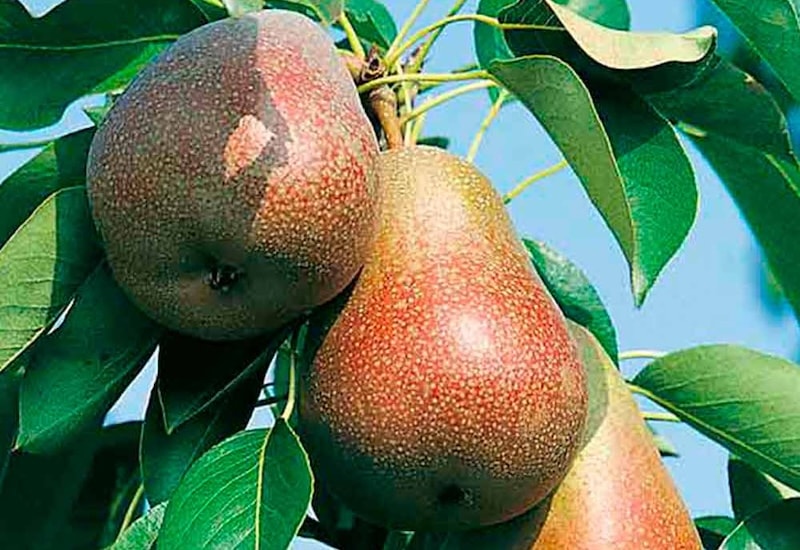
Image: Pear ‘Beurré Hardy’ from Suttons/Copyright: Floramedia
Once established, you can expect your fruit trees to be highly productive, and it’s quite likely that even a youngish tree will yield more fruit than you can easily consume by yourself! Most species, but particularly pear, plum and apple trees, benefit greatly from fruit thinning. The judicious removal of some of the developing fruitlets means you’ll get larger, higher quality fruits, and prevent the branches from snapping under their own weight.
Your trees will naturally lose a proportion of their immature fruits in June, a phenomenon known as ‘June Drop’ which is thought to be a result of competition for moisture and nutrients. Normally, the weakest fruits will drop of their own accord. If you need to thin further, wait until after the June Drop, in early July.
Thin apple and pear trees to two or three fruits per cluster, leaving the largest fruit on the tree – except the ‘king’ fruit, which is the large, often misshapen fruit at the centre of each cluster, which you should remove.
In most years, plums ‘set’ far more fruits than the tree can comfortably bear and removing up to three-quarters of the fruit will avoid broken branches and ensure a high-quality crop. If you’re growing peaches and nectarines, thin them out to leave a space of about 20cm (8″) between each fruit. Modern apricot trees have the ability to carry all set fruit to maturity with little reduction in quality, but thinning to allow 7.5–10cm (3–4″) space between each apricot results in even larger fruits. Cherry trees, medlar, nuts, and mulberry do not need thinning.
Do fruit trees need pollination partners?

Image: Fig Negronne (Violette De Bourdeaux) from Suttons
Many of our fruit and nut trees are self-fertile, which means that they will set a good crop of fruit without the need for pollen from another tree. The remainder of our trees do show at least a degree of self-fertility. This means that a useful crop can be expected even if a pollinating partner is absent. However, if pollen from another tree is introduced by visiting bees, the resultant crop will be heavier. It’s always best to plant at least two fruit trees if there isn’t another one nearby in a neighbour’s garden.
It’s also worth noting that some fruit trees, like peaches and nectarines, flower very early in the spring, often before many pollinating insects are active. In this case, it’s well worth giving nature a helping hand by introducing a very soft artist’s brush into each flower to transfer pollen from one to another.
If you don’t have enough room to plant multiple trees and you haven’t got self-fertile varieties, it’s not the end of the world. In spring, your garden will attract a great number of pollinating insects. Often, these insects travel significant distances and alight on a number of fruit trees along the way. The strong likelihood is that they will bring useful pollen from your neighbours and introduce it to your trees.
Growing fruit trees is possible even for those gardening small plots, courtyards and balconies. Our patio fruit trees are designed to thrive in pots and containers. If you’re interested in more information on growing fruit trees, make sure you head over to our gardening advice section, where you’ll find a wealth of helpful articles and expert tips to help you succeed.
Lead image: Apple ‘Laxton’s Superb’ from Suttons
Last Updated on July 29, 2025 by Suttons Horticultural Team

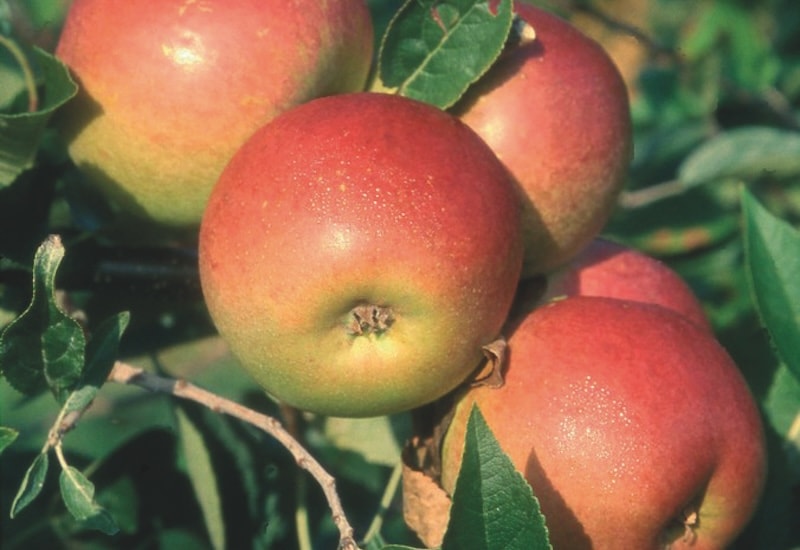



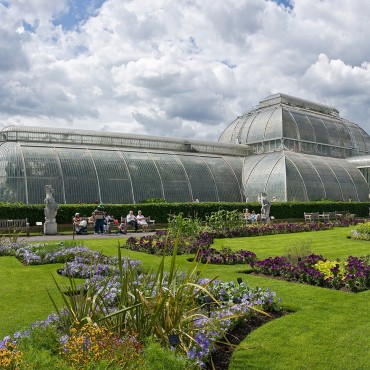
Brilliant advice, I have to put into action everything that was written here. Thank you for sharing.
Excellent advice ! I have bare root apple, pear and plum bound for a sunny garden. I needed to know whether or not it was worth bringing them on indoors then planting out later than normal to balance temperature change . Now having read your article , should I keep them cold , dry and dormant until planting out time ? I’m situated in NE Scotland on the Moray coast . Temperatures are higher than most of Scotland. Any advice will be most welcome . Thankyou … Chris .
Hi Suttons
I am pleased to say that I have retired now from a very demanding job. We are planning to move to Cheshire, hoping everything goes through. It is then that I will need your help and expertise. I wish to grow a small orchard (always been my dream) and if we manage to get the property we are after it will happen. I then need to grow a tapestry boundary again with your help and have a beautiful garden – lots to do. I get your regular emails of all the exciting wonderful things to grow (being within the horticultural business – commercial cut flower 25 years previously, I get so excited but can’t do anything until it all happens but will keep in touch. Lots of advice like above needed.